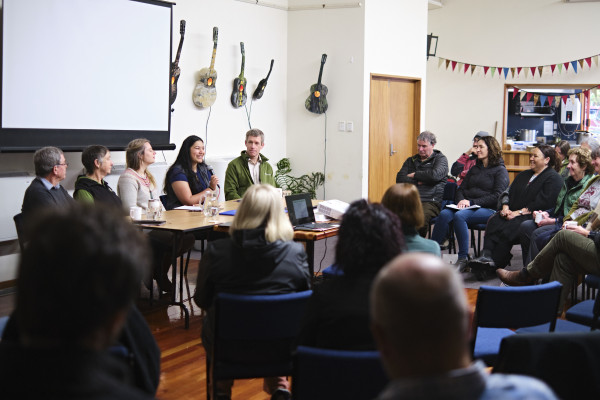Celebrating 25 years of Predator Free Whenua Hou
Jul 15, 2024
Rare species are thriving at the bottom of New Zealand thanks to efforts to make an island sanctuary predator free 25 years ago.
Whenua Hou (Codfish Island) is an island to the west of Rakiura (Stewart Island). It is here that Ngāi Tahu, DOC, and conservationists have worked to create a haven for the critically endangered kākāpō, the mohua (yellowhead), kuaka (Whenua Hou diving petrel), and pekapeka-tou-poto (lesser short-tailed bat), along with other species.
Over Matariki, dozens came together on Rakiura to celebrate and reflect.
“The 25-year milestone celebrations focused on the past, present and future of Whenua Hou and looked towards the goal of a Predator Free Rakiura,” Chair of the Whenua Hou Komiti Tāne Davis says.
“An overarching theme from the weekend was the need for greater recognition of the cultural, archaeological and historical significance of Whenua Hou alongside its conservation value, and the ongoing mahi involved to maintain its predator free status,” Tāne says.
“The second was the urgent need to bring the learnings of the past 25 years on Whenua Hou across to its much larger neighbour, Rakiura, in the hope of one day returning kākāpō to the island that was originally their home,” he says.
“There have been 11 breeding seasons on Whenua Hou since kākāpō were translocated there and in that time 162 chicks have fledged,” Tāne says.
Organised by the Whenua Hou Komiti and other Southland Conservation Board members, a two-day event at the Stewart Island Community Centre featured a mihi whakatau, where the community welcomed those attending the celebrations, followed by an evening dinner. Those present included conservationists, Ngāi Tahu and Papatipu Rūnanga representatives, and an ope (delegation) from Ngāti Manuhiri, the iwi with kaitiakitanga over Te Hauturu-o-Toi (Little Barrier Island), where a trial population of kākāpō from Whenua Hou has been established.

The event saw a panel discussion on biodiversity, a presentation from members of the Department of Conservation’s Kākāpō Recovery team, and short talks on the archaeological, cultural and historical context of Whenua Hou.
A regular stopping-off point for Southern Māori enroute to the Tītī Islands, the archaeological record shows evidence that Whenua Hou was occupied from the 1300s.
“Whenua Hou is a place of immense significance for Ngāi Tahu whānui,” Tāne says.
“We connect to the island on many levels – culturally, physically, spiritually and through our shared whakapapa links,” he says.
“Our tīpuna wahine formed unions with European whalers and sealers, creating the first mixed race settlement in Aotearoa on Whenua Hou and many Ngāi Tahu descend from these partnerships.”
The iwi sought the return of the island from the Crown as part of the Ngāi Tahu Settlement.
However, while the 18 former Crown Tītī Islands were returned to Rakiura Māori, the application to have Whenua Hou returned was denied and the Whenua Hou Komiti was established, consisting of four representatives from the Murihiku Rūnanga and four Southland Conservation Board members.
Tāne, who represents Ōraka-Aparima on the Komiti, has held the role of Chair for the 25 years that the Komiti has existed.
“I feel it is my duty and responsibility to honour those kaumātua who represented Ngāi Tahu in the Settlement, including my mother and father, and to continue to express the importance of our Ngāi Tahu connection with Whenua Hou,” Tāne says.